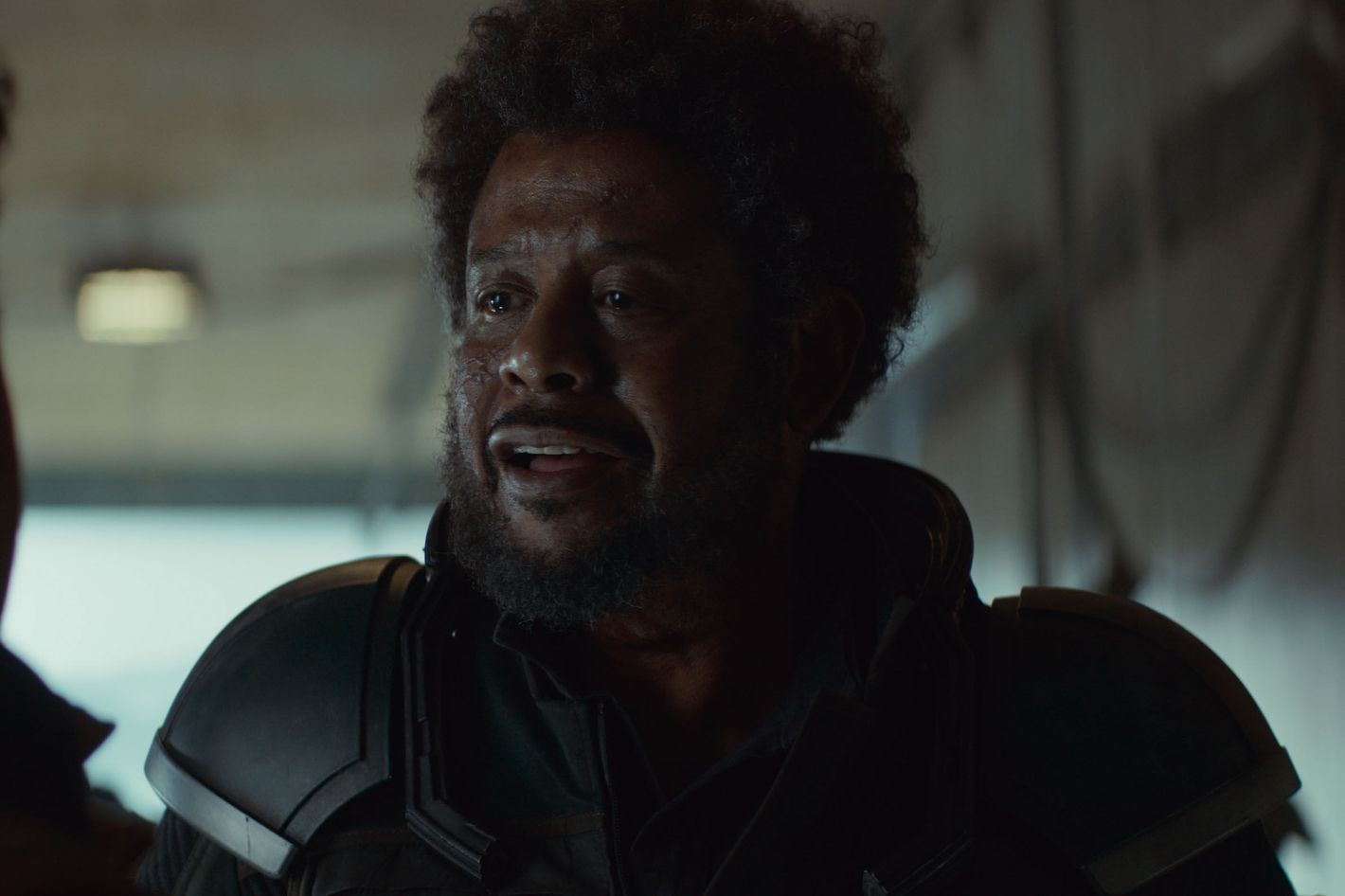

Spoilers follow for the second season of Andor through its sixth episode, and the 2016 film Rogue One: A Star Wars Story.
We probably weren’t meant to love Saw Gerrera. The rebel leader played by Forest Whitaker in Rogue One: A Star Wars Story (the inspiration for Andor and the narrative point the series is working toward) is introduced as more machine than man: clanking metal legs, an oxygen mask, and a wild look in his eye that suggests paranoia and menace. The character’s name is a clear nod to Marxist revolutionary Che Guevara, but his treatment in Rogue One felt more like a rebuke than celebration.
The Rebel Alliance calls him an “extremist,” while Imperial officer Krennic sneers that he’s a “fanatic,” the two enemies united in seeing Saw as a maniac because of his willingness to torture and his reliance on guerrilla tactics. When he gasps out in his dying moments, “Save the Rebellion. Save the dream!,” those last words sound almost apologetic, like Saw is realizing the fruitlessness of his years of fighting. Saw doesn’t surrender, but his death during the destruction of Jedha City is an anticlimactic end, far less heroic than how Cassian and Jyn die getting the Death Star’s blueprints in the Rebellion’s hands. Presenting Saw as less noble because he broke away from the mainstream organization of the Rebellion is Star Wars maintaining the same narrow understanding of right and wrong that it’s always had. But Andor distinguishes itself in the gray, in the ambiguities of war that the larger Star Wars franchise largely rejects. (Remember, this was once a story for children!) And within Andor’s milieu, Saw Gerrera has grown into the series’ most fascinating invention, its clearest distillation of anti-colonial thought, and the man to whom I, like Wilmon Paak, am ready to pledge my devotion. Hand over that rhydo, Saw, let’s get to work!
Where the first season of Andor primarily followed Cassian’s growth from indignant smuggler to mission-committed spy under Luthen Rael’s wing, the second season has taken more of a “Now what?” approach. As Andor explores the difficulties involved in building a coalition united in its aims, the first two chapters of this season have leaned on Saw, who remains an outsider in this pre–Rogue One timeline, but who with each appearance in the series has become more fleshed out, more understandable as a product of his circumstances, and an embodiment of how difficult it is to reach consensus.
In Saw’s first scene in the series, in season one’s “Narkina 5,” we see the outline of the deeply mistrustful man he would become five years later in Rogue One. He’s coherent and caustic in equal measure, mistrustful of Luthen’s invitation to work together, and insulting toward the other factions throughout the galaxy, including “Maya Pei,” whom he calls “a neo-Republican,” and “the Ghorman Front.” When season two starts a year later in BBY 4, Saw’s warnings against these groups turn out to be prescient, affirming his read that neither forming an alliance nor waging an uprising is as easy as one might think. The Maya Pei brigade, undisciplined and petty as they hold Cassian captive, fight among themselves until they’re all killed. The Ghorman Front is untested and amateurish, easily manipulated by the Empire and quick to panic. (Would a more experienced group have accidentally killed Cinta? Probably not.)
Their newness to the cause is particularly stark when we see Saw again in season two’s fourth episode, “Ever Been to Ghorman?” On the planet D’Qar, his followers are regimented, organized, and ready to be trained for a new challenge presented by Luthen’s agent Wilmon Paak (Muhannad Bhaier): how to steal the highly volatile fuel rhydonium, which Saw speaks about practically lovingly. Knowing how to handle the unstable “rhydo,” Whitaker purrs, creates “a galaxy of opportunities” for those who can poach it — no matter that it can kill you by melting away your skin or burning you from the inside out. Handling rhydo is a test, one that gauges how much of themselves these rebels are willing to give over to the cause. Saw expects it all, of course, and his mentor-mentee relationship with young Wilmon, who turned rebel after the Imperial Security Bureau tortured, killed, and publicly hanged his father Salman back home on Ferrix, then becomes an echo of Luthen and Cassian’s.
Where Luthen pushed Cassian into joining the war by practically forcing him into mercenary service on Aldhani, Saw strong-arms newly nicknamed “Wilmon the Boy” into accompanying his group to another planet to steal rhydo. And where Cassian realized that Luthen’s willingness to take bold risks and strike at unexpected targets was key to advancing the Rebellion’s cause, so too does Wilmon grow to understand Saw’s ruthlessness and recklessness as a by-product of living so long under oppression, and as a way to combat the Empire’s fetishization of obedience. In fifth episode “I Have Friends Everywhere,” we witness Saw’s gleeful speechifying to Wilmon about the Rebellion’s fighters being “the rhydo … the fuel” for the cause. Here, Andor repositions Saw from someone who is unusual because of his savagery and instability to someone who could only turn out this way because of what he’s lived through.
If Luthen serves as Andor’s accelerationist spin on Darth Vader, then Saw is its armed Frantz Fanon, a prism for critical theory as seen through a kyber crystal. So much of Saw is informed by the anti-colonialist philosopher’s observations about the psychological toll of living under imperialism in 1961’s The Wretched of the Earth, in which Fanon wrote about how “the muscles of the colonized are always tensed” and argued that “decolonization is truly the creation of new men.” Saw tells his followers he was forced into slave labor at an Imperial work camp on his home planet Onderon. What else can one do in the face of such unrelenting hate than lose their mind, then lose themselves? But in Rogue One, when Saw’s surrogate daughter Jyn Erso says she ignores seeing the “the Imperial flag reign across the galaxy” by refusing to look up, Saw is horrified by her indifference. He wants his comrades to find themselves in the struggle, to gaze upon the Empire’s crest and realize they’d do anything to tear it down.
Maybe it’s insane to expect to win such a lopsided fight. And, yeah, Saw huffing on the very combustible rhydo probably doesn’t help him stay even-keeled. (Suddenly, that oxygen mask — or is it? — in Rogue One takes on a new significance.) But for all the delirious flair Whitaker brings to Saw in this scene, all the grandness and the bombast, he injects an undercurrent of pitiable zeal, too, through the knowledge that his days in a war this high-stakes are numbered. His speech to Wilmon as the younger man taps into a rhydo pipe — “Revolution is not for the sane. Look at us. Unloved. Hunted. Cannon fodder. We’ll all be dead before the Republic is back and yet … here we are” — doesn’t feel like Saw high on his own hot air, but a religious leader appealing to his congregation, assuring them of their own self-worth. His “Remember this, remember this moment” brings to mind Nemik’s “Remember this: try” manifesto from season one; his “Let it in, boy. That’s freedom calling!” is a galvanizing call to action.
No mainstream Rebellion leader in Andor has delivered anything half as rousing. No moment in Andor has been this clearly influenced by philosophies like that of Fanon, whose belief that the lack of armed resistance against oppression results in “a constant and considerable stream of mental symptoms.” Where others consider Saw insane for his brutality, by his reasoning, it’s insane to do anything other than attempt to upend the Empire. In humanizing Saw, Andor blows up Rogue One’s façade of a placid Rebellion being the more noble one and urges us to breathe in the dangerous but intoxicating possibility that extremism might have a role to play in revolution.
Related

Latest News
For Sale! 2016 Sea Ray 350 Sundancer – $180,000
Reel Deal Yacht is pleased to feature a meticulously maintained 2016 Sea...
NFL fines Falcons and defensive coordinator Jeff Ulbrich following prank call to Shedeur Sanders
The Atlanta Falcons have been fined $250,000 and defensive coordinator Jeff Ulbrich...
Barcelona and Inter Milan draw 3-3 in thrilling first leg of their Champions League semifinal
Lamine Yamal’s curler that went in off the post after the teenager’s...
Atlanta’s Dyson Daniels wins the NBA’s most improved player award
Dyson Daniels’ emphasis on defense earned him a starting job in his...
Phoenix Mercury are heading into new era without Diana Taurasi and Brittney Griner
The Phoenix Mercury will open their first season in 21 years without...














Leave a comment